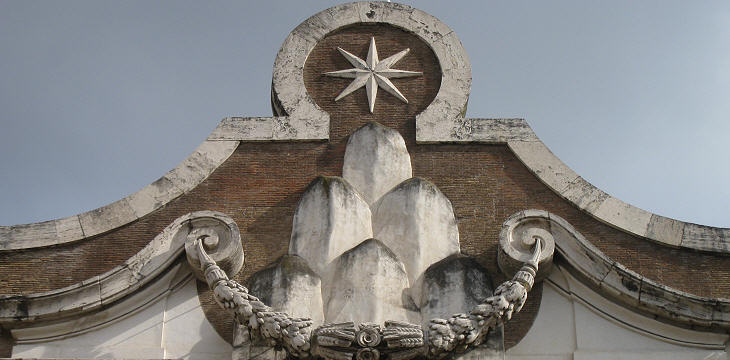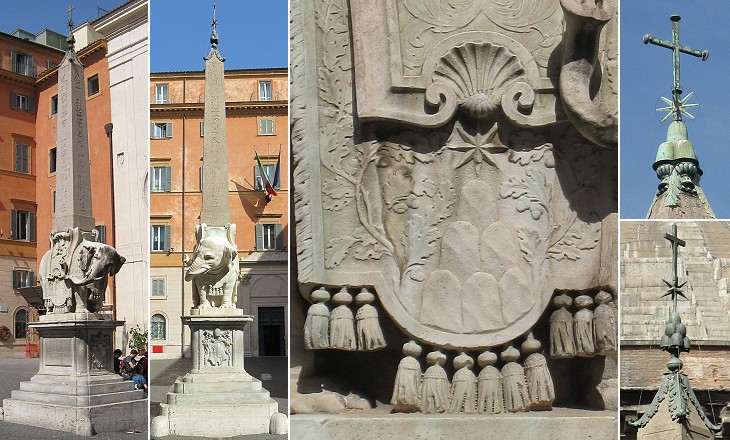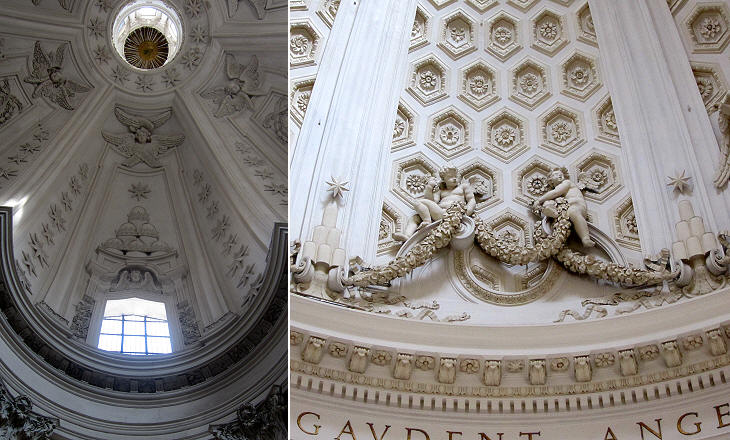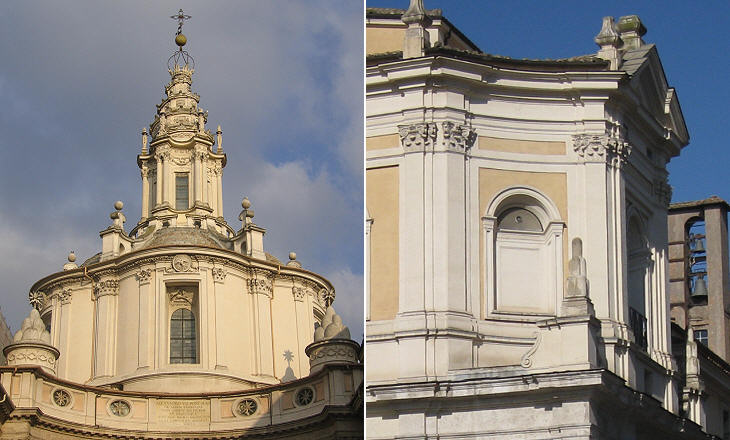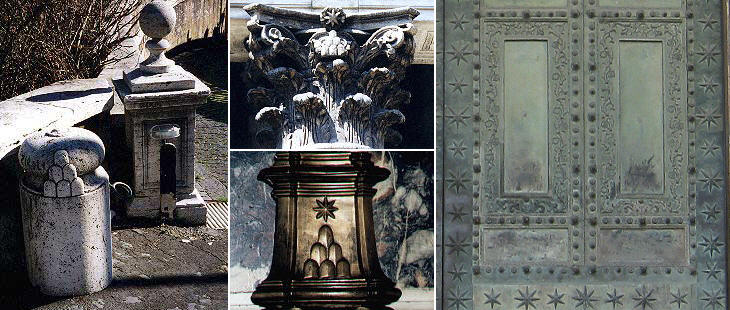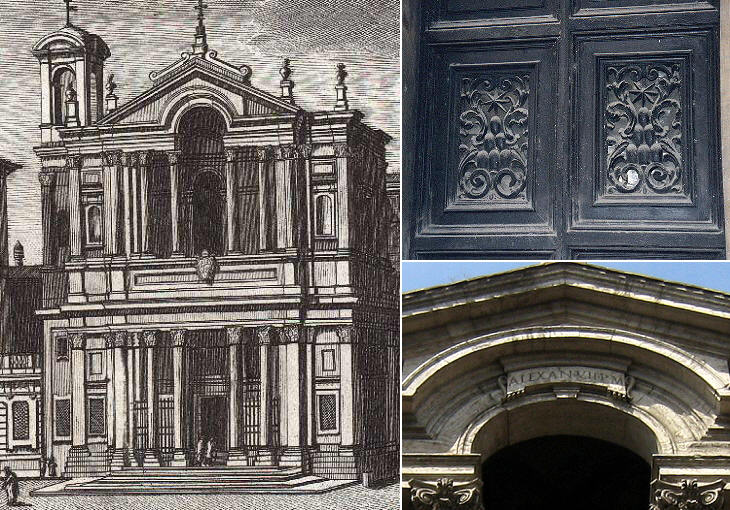  What's New! Detailed Sitemap All images © by Roberto Piperno, owner of the domain. Write to romapip@quipo.it. Text edited by Rosamie Moore. |
 SIX MOUNTAINS AND A STAR SIX MOUNTAINS AND A STAR(decoration of one of the entrances of the Pope's palace at Castelgandolfo) Alexander VII - Fabio Chigi Cardinal Fabio Chigi chose the name of Alexander VII in memory of Pope Alexander III who had fought Emperor Frederick I to preserve the independence of the Church. Alexander had become a most unsuitable name after Alexander VI Borgia. Nevertheless when in St Peter's Square one sees the name of Alexander VII repeated so many times and the six (remaining) coats of arms, no doubt the idea that Alexander the Great was the reference for Fabio Chigi when he named himself Alexander, comes to mind. Alexander VII was a man very interested in the arts and he personally reviewed with Bernini the possible solutions for the square which was to complete St Peter's. His coat of arms is everywhere in Rome, not only on buildings he erected, but also on many he just slightly restored. Alexander VII feared that his formal coat of arms might not survive the many hazards of history and he had artists develop decorations with its themes in the belief that art would always be respected. This page is dedicated to this aspect. Of the two elements of his coat of arms he thought the six mountains with the star would better represent him, as the oak was already associated with Sixtus IV and Julius II Della Rovere. Piazza del Popolo
Queen Christina of Sweden embraced the Catholic faith and this event led to the belief that other kings or queens might follow her example. For her arrival in Rome in 1655 Alexander VII had Bernini to decorate the inner side of Porta del Popolo. "Felici Faustoque Evento" (to the happy and propitious event) one can read in memory of her entrance, but besides Queen Christina the six mountains honour Alexander VII. Balustrades
Examples where both themes of the coat of arms are used can be found in decoration of balustrades in churches. The picture shows (above) Santa Maria dell'Assunzione in Ariccia, a little town near Albano where the Chigi had a large palace (and almost everything was theirs); this church is one of Bernini's greatest accomplishments. (below) The church of St. Catherine in the center of Rome The Elephant
There are more Egyptian obelisks in Rome than in the rest of the world! Most of them are topped by mountains and a star, but usually the mountains are three in memory of other popes (mainly Pope Sixtus V, but also Pope Clement XI and Pope Pius VII). Only the elephant in Piazza S. Maria sopra Minerva bears an obelisk tipped by the six mountains of Alexander VII. It was designed by Bernini (the elephant is a work by Ercole Ferrata). The little monument still retains the formal coat of arms of Alexander VII. But to secure the memory of the pope Bernini decorated the caparison of the elephant with both the oak and the six mountains. For an example where only the decoration survived see Ferrara. Interiors of Churches
Another way to preserve the pope's memory was to decorate with the six mountains the interior of church domes. Here are the interiors of St. Yves (left) by Borromini and of S. Maria dell'Assunzione in Ariccia (right) by Bernini. Exteriors of Churches
The use of the six mountains as a decoration of the fašade was another way to preserve the memory of the pope. Although St. Yves was built under his predecessors and its shape took after the bee of Pope Urban VIII, the mountains were added with an unhappy result. The simple church of St. Rita (once below the steps of Capitol Hill and then rebuilt near the Theatre of Marcellus) has a better outcome. Unexpected Encounters
The six mountains and the star of Alexander VII can also be found on very minor works like a small pier near the fountain of Acqua Paola or in one of the columns on the left side of the Pantheon (on another column there is the bee of Urban VIII) or in a chandelier in St Peter's. Alexander VII decided to move the bronze doors of the Roman Curia to S. Giovanni in Laterano. As the doors of the Basilica were larger than those of the Curia, Borromini included them in a new bronze frame decorated with stars and acorns (a reference to the oak). In Santa Maria del Popolo
This church was built by Sixtus IV and retains several coats of arms with the pope's oak tree. The interior was almost entirely renovated by Bernini who added many coats of arms of Alexander VII. Those of the organs are of a special interest: not only did Bernini strictly associate the coat of arms with the angels bearing them, but he also inserted in the organ the oak tree of the Chigi. The floor under the altar is decorated alternately with the mountains and the oak tree. The dome of the Chigi chapel is topped by the mountains and the star. Santa Maria in Via Lata
Via Lata means the large/ample street. It is today Via del Corso. Santa Maria in Via Lata is a very old church (with a coat of arms of Innocent VIII on the side): the fašade was renovated by Pietro da Cortona. The church is situated close to the Pamphylj palace and the renovation started under Pope Innocent X Pamphilj but the pope died and his successor Alexander VII received the credit. In this case however his coat of arms disturbed the glory of the nearby Pamphilj and today it is no longer there. The memory of Alexander VII is nevertheless, although with less appearance, assured by the mountains and the star on the main door (and by his name on the top of the loggia). The Villa
The great families of the XVIIth century had three palaces and the Chigi were no exception. One in Rome: Palazzo Chigi is in the center of Rome in Piazza Colonna: you can see in the background the decoration of the little balcony. The second palace was outside the walls but not too far. Villa Chigi, off Porta Pia, has retained the decoration with the mountains and the star (see above). The third palace was in the fief of the family (Ariccia for the Chigi).  See also the six mountains and the star in the Fountain of Acqua Acetosa. The image below and above shows the frieze of Francesco Borromini in Battistero di S. Giovanni in Laterano. SEE THESE OTHER EXHIBITIONS (for a full list see my Detailed Index) 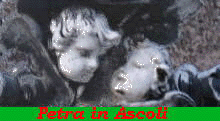 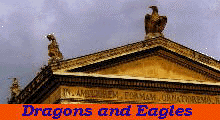 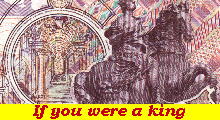 |
